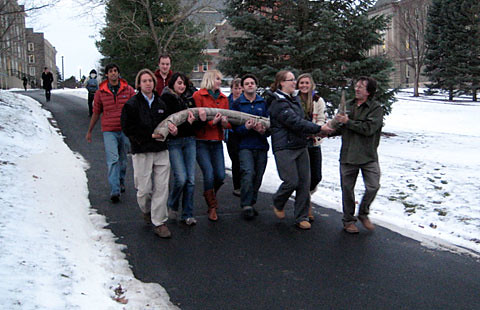Most days on the Academic Quad, you’ll find students carrying backpacks and occasional care packages from home.
On Tuesday, though, you would have seen volunteer geology students carefully toting two large fossils: a mastodon tusk that is more than 10 feet long and approximately 200 pounds and a whale jaw bone that also tips the scales at about 200 lbs.
The fossils were some of the first to be moved from the Robert M. Linsley Museum in Lathrop Hall to the museum’s new home in the .
The tusk comes from a former local resident. It was discovered in the Preston Hill Bog, which is near the intersection of Horton Road and Preston Hill Road, just a couple miles from campus, according to Bruce Selleck, Harold Orville Whitnall Professor of Geology.
The mastodon is believed to have lived in the area sometime between 13,500 years ago, when a major ice sheet retreated, and 10,500 years ago, when the massive elephant-like animals became extinct.
 |
| The mastodon tusk is carried through the Quad to its new home at the Ho Science Center. |
The jaw bone of the whale was discovered near Plattsburgh, N.Y., said Selleck. It is between 10,500 and 8,000 years old, a period when marine waters were present in the Lake Champlain Valley.
Both items have been in 51łÔąĎÍř’s possession since the late 1800s.
Supervising the fossils’ move across the Quad was Di Keller ’81, senior lecturer in the Geology Department, and David Linsley, a geology technician in the department who is the son of the late Robert Linsley, for whom the museum is named.
Robert Linsley taught at 51łÔąĎÍř from 1955 to 1992, specializing in courses related to paleontology and evolution.
All the fossil, mineral, and rock specimens in the Lathrop museum are scheduled to be moved to the Ho Science Center space in the coming months, said Richard April, Dunham Beldon Jr. Professor of Geology.
April and Keller have been working with other department members and The Exhibition Alliance in designing the new museum. The university is raising funds for it through a matching grant gift provided by Sylvia and Malcolm Boyce ’54.